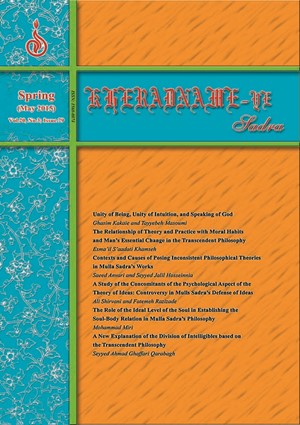-
-
List of Articles
-
Open Access Article
1 - سرمقاله
Seyyed Mohammad Khamenei -
Open Access Article
2 - Unity of Being, Unity of Intuition, and Speaking of God
Ghasim Kakaie Tayyebeh Masoumi -
Open Access Article
3 - The Relationship of Theory and Practice with Moral Habits and Man’s Essential Change in the Transcendent Philosophy
-
Open Access Article
4 - The Relationship of Theory and Practice with Moral Habits and Man’s Essential Change in the Transcendent Philosophy
Esma’il S’aadati Khamseh -
Open Access Article
5 - Contexts and Causes of Posing Inconsistent Philosophical Theories in Mulla Sadra’s Works
Saeed Anvari -
Open Access Article
6 - A Study of the Concomitants of the Psychological Aspect of the Theory of Ideas: Controversy in Mulls Sadra’s Defense of Ideas
Ali Shirvani Fatemeh Razizade -
Open Access Article
7 - The Role of the Ideal Level of the Soul in Establishing the Soul-Body Relation in Mulla Sadra’s Philosophy
Mohammad Miri -
Open Access Article
8 - A New Explanation of the Division of Intelligibles based on the Transcendent Philosophy
Seyyed Ahmad Ghaffari Qarabagh
-
The rights to this website are owned by the Raimag Press Management System.
Copyright © 2017-2026







